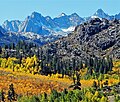Clyde Spires
| Clyde Spires | |
|---|---|
 North aspect | |
| Highest point | |
| Elevation | 13,267 ft (4,044 m)[1] |
| Prominence | 80 ft (24 m)[2] |
| Parent peak | Mount Wallace (13,377 ft)[3] |
| Isolation | 0.50 mi (0.80 km)[3] |
| Coordinates | 37°08′24″N 118°38′54″W / 37.1401228°N 118.6483761°W[4] |
| Naming | |
| Etymology | Norman Clyde[5] |
| Geography | |
| Location | Kings Canyon National Park Fresno County / Inyo County California, U.S. |
| Parent range | Sierra Nevada |
| Topo map | USGS Mount Darwin |
| Geology | |
| Age of rock | Cretaceous |
| Mountain type | Fault block |
| Type of rock | Granite[6] |
| Climbing | |
| First ascent | 1933[6] |
| Easiest route | class 4[3] |
Clyde Spires is a 13,267-foot-elevation (4,044 meter) mountain summit located on the crest of the Sierra Nevada mountain range in California, United States.[4] It is situated on the boundary shared by Kings Canyon National Park with John Muir Wilderness, and along the common border of Fresno County with Inyo County. It is 20 miles (32 km) west of the community of Big Pine, and 0.5 miles (0.80 km) southeast of Mount Wallace, which is the nearest higher neighbor.[2] The west spire is slightly higher than the east spire.[1] Topographic relief is significant as the spires rise 1,665 feet (507 meters) above Echo Lake in 0.38 miles (0.61 km).
History[edit]
The first ascent of the spires was made July 22, 1933, by Norman Clyde, Jules Eichorn and Ted Waller, who were members of the Sierra Club.[7] They named the landform for Norman Clyde (1885–1972), the leader of the group and legendary mountaineer credited with 130 first ascents, most of which were in the Sierra Nevada.[8] The toponym has been officially adopted by the United States Board on Geographic Names.[4]
Climate[edit]
Clyde Spires is located in an alpine climate zone.[9] Most weather fronts originate in the Pacific Ocean, and travel east toward the Sierra Nevada mountains. As fronts approach, they are forced upward by the peaks (orographic lift), causing them to drop their moisture in the form of rain or snowfall onto the range. Precipitation runoff from this geographic feature drains north to Bishop Creek, and south into Middle Fork Kings River.
Gallery[edit]
See also[edit]
References[edit]
- ^ a b R. J. Secor, The High Sierra Peaks, Passes, Trails, 2009, Third Edition, Mountaineers Books, ISBN 9781594857386, page 291.
- ^ a b "Clyde Spires, California". Peakbagger.com. Retrieved 2022-06-11.
- ^ a b c "Clyde Spires, West - 13,260' CA". listsofjohn.com. Retrieved 2022-06-11.
- ^ a b c "Clyde Spires". Geographic Names Information System. United States Geological Survey, United States Department of the Interior. Retrieved 2022-06-11.
- ^ Robert C. Pavlik (2008), Norman Clyde: Legendary Mountaineer of California's Sierra Nevada, Heyday Books, ISBN 9781597141109, p. 99
- ^ a b Alan M. Hedden and David R. Brower, A Climber's Guide to the High Sierra (1954)
- ^ John Moynier, Claude Fiddler (1993), Sierra Classics: 100 Best Climbs in the High Sierra, Chockstone Press, ISBN 9780934641609, p. 158
- ^ Peter Browning, Place Names of the Sierra Nevada From Abbot to Zumwalt, 1986, Wilderness Press, ISBN 9780899970479, p. 42.
- ^ "Climate of the Sierra Nevada". Encyclopædia Britannica.
External links[edit]
- Weather forecast: Clyde Spires
- Clyde Spires rock climbing: Mountainproject.com
- Clyde Spires (photo): Flickr







